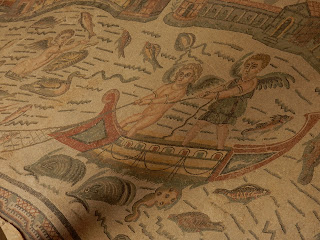il 22 aprile
Ragusa, Sicily
Today's discovery began with a tour of the ruins of La Villa Romana del Casale, an absolute treasure in the verdant countryside of southern Sicily and sitting below Mount Mangone. Constructed in the 4th century A.D. (between 310 and 340) on a series of terraces, the villa, which is more like a palace, suggests, by its grandeur and lavishness, to have been built either on the orders of a Roman ruler or a very rich and successful landowner. Not only is its size remarkable, but the mosaics that cover the floors throughout the villa are exceptional for their quality, richness, and sheer creativity.
The villa, thought to have been occupied up until the Arab invasion in the 9th century, although in an increasing state of degradation, was finally destroyed by the Norman ruler of Sicily, William I the Bad in 1155 and ultimately covered by a landslide not long after. It was the only the result of painstaking excavations in the 20th century that some of the finest Roman mosaics in Europe were revealed, making the Villa Romana del Casale a UNESCO World Heritage Site.
The city, initially built on a hill, was to be controlled by Carthaginians, Romans, Byzantines, Arabs, and, finally, like the rest of the Kingdom of Sicily, be taken over by the Normans in the 11th century.
An earthquake in 1693 killed over 5,000 inhabitants; the city was rebuilt and many of the baroque buildings still standing date from this period. Many who survived chose to move to a new settlement (Ragusa Superiore) and the city's older section then became known as Ragusa Inferiore (Ragusa Ibla). The two sections, separated geographically by the Valle dei Ponti, joined together in 1926 and became the provincial capital the following year. The ravine between the two sections is filled with houses and churches and is easily crossed on foot, (well, with a bit of walking!)
From the Upper Town the views of the surrounding countryside are quite beautiful and the baroque architecture of the Cathedral of San Giovanni Battista is a must on any visit.






























No comments:
Post a Comment